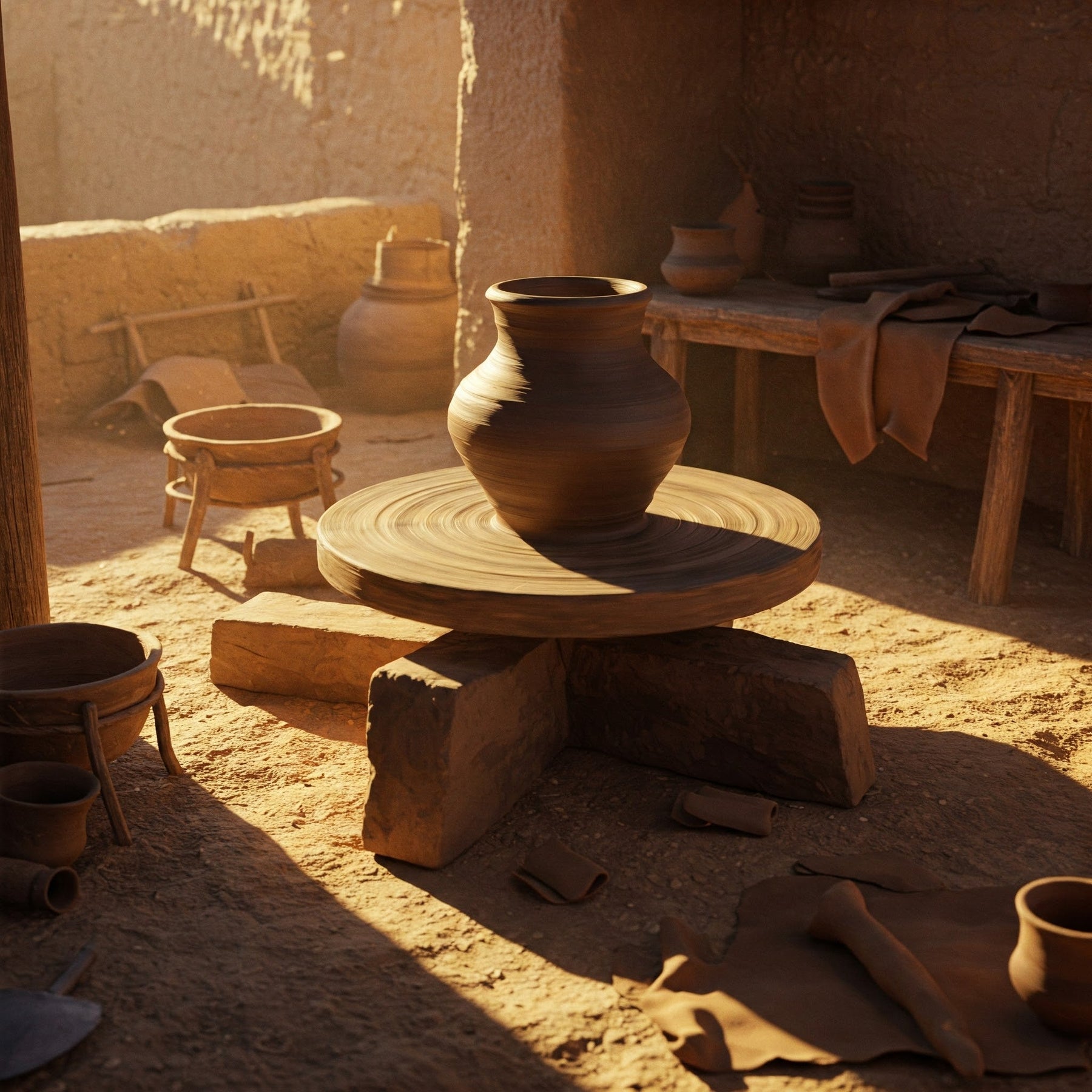
Why Was the Pottery Wheel Invented? Discover Its Surprising Origin
Why was the Pottery Wheel invented? The short answer: to stop ancient potters from losing their minds shaping lumpy pots! Dive into its History & Invention to uncover how spinning clay transformed storage, boosted trade, and gave pottery a symmetrical makeover—because uneven bowls were never in fashion!

The Pottery Wheel Origins: Early Shaping Methods
Before potters started spinning clay, shaping ceramics was a labour of patience. Imagine spending days moulding a single pot, only to realise it still wasn’t quite right!
Pre-Wheel Pottery Techniques
Hand-Building (Pinching, Coiling, Slab Building)
Long before spinning wheels, potters shaped clay using their hands, fingers, and simple tools. Techniques like pinching involved pressing and moulding clay directly. Coiling meant stacking thin clay ropes one by one to form vessels. Slab building meant joining flat pieces of clay into shapes—a bit like assembling an elaborate clay puzzle.
Moulded Pottery
Another clever trick involved moulds. Potters pressed clay into carved wooden or stone moulds, creating more uniform shapes. This sped things up slightly, but each piece still demanded careful attention, limiting scale and creativity.
The Limitations of Early Techniques
Despite their charm, these early methods had obvious flaws.
Time Consumption
Hand-making pottery took ages. Imagine needing to store grain from a bumper harvest, yet having only a handful of pots ready after weeks of effort—far from ideal.
Shape Consistency
Without wheels, pots often came out slightly crooked, uneven, or fragile. Storage jars that wobbled or leaked weren't exactly practical!
The Invention of the Pottery Wheel: A Revolutionary Leap
Ancient potters finally said enough was enough. Enter the pottery wheel—humanity’s first real attempt at mass production.
Archaeological Evidence of First Pottery Wheels
Around 4500 BCE, some clever folks in Mesopotamia came up with a rotating device to shape pots evenly. Excavations at Tell Brak in modern-day Syria revealed wheel-made fragments, proving ancient humans weren't just smart—they also disliked uneven pots as much as we do.
The Driving Forces Behind the Invention
But why did these ancient people invent the pottery wheel specifically?
Increased Demand for Pottery
Societies grew rapidly. More mouths meant more food—and more pots to store it all. Potters were simply overwhelmed.
Efficiency and Standardisation
Ancient markets needed pots that looked alike—no surprises. Wheels offered consistency at scale, turning pottery into a reliable commodity rather than just an art form.
Agricultural Surplus and Storage Needs
When early civilisations discovered farming, they needed a solution for storing surplus grain. This required durable, uniform containers. Wheels made crafting large, sturdy jars quick and efficient.
Mechanics of the Early Wheel
Early pottery wheels were surprisingly simple, yet incredibly effective:
|
Type |
Design |
Key Advantage |
|
Tournette |
Simple rotating disc |
Easy to carry, simple to use |
|
Kick Wheel |
Foot-powered turntable |
Allowed potters both hands free |
This simple comparison highlights the clear progression from basic tools to more complex machinery that significantly changed pottery production.
The Benefits of the Pottery Wheel: A Craft Transformed
The pottery wheel’s arrival completely changed how societies functioned—economically, artistically, and socially.
Faster Vessel Production
The wheel allowed potters to produce multiple pots in the time it once took to make one. Picture the relief of crafting ten vessels effortlessly instead of painstakingly forming one.
Perfect Symmetry Every Time
Ancient Greek and Roman potters created beautifully symmetrical vases that we still admire today. Without wheels, these elegant curves would have been near impossible.
Thin-Walled and Durable Vessels
Wheels enabled thin, delicate walls, lighter yet stronger vessels, ideal for transport, storage, and even intricate artistry.
Creative Freedom and Innovation
With wheels, artists suddenly found freedom. Pots were no longer just practical—they became decorative masterpieces. Intricate patterns, delicate handles, and elaborate shapes flourished, demonstrating true artistic flair.
The Societal Impact of the Pottery Wheel
The wheel wasn’t merely about better pottery; it reshaped society and trade.
Specialisation of Labour
Pottery became a profession. Communities no longer needed everyone to make their own pots, freeing others to farm, trade, or build.
Economic Growth Through Trade
Consistent pottery opened new trading routes between regions. Storage jars, dishes, and vessels travelled far and wide, increasing wealth and cultural exchange.
How the Pottery Wheel Evolved Through Time
Over centuries, pottery wheels became smarter and faster, mirroring human development itself.
Early Civilisations to Medieval Times
Early potters manually spun simple wheels. By medieval times, potters used foot-powered wheels, significantly speeding production and quality.
Industrial Revolution: Mass Production Begins
The arrival of mechanised pottery wheels in factories dramatically accelerated production, allowing entire towns like Stoke-on-Trent to thrive economically.
Pottery Wheels Today: Still Turning Strong
Even now, the pottery wheel is more than a relic; it remains essential in modern ceramics.
Contemporary Ceramics
Walk into any pottery studio today, and you'll spot electric pottery wheels—faster, quieter, and more precise. They still rely on the same simple principles used thousands of years ago.
Archaeological Significance
For archaeologists, pottery wheels aren’t just tools—they’re windows into ancient societies. The shapes, sizes, and techniques used provide insights into trade routes, societal structures, and cultural values.
Conclusion: A Turning Point in Human History
So, why was the pottery wheel invented? Ultimately, it solved a very human problem: making life easier. What began as a simple solution to wobbly pots transformed into one of history’s most impactful inventions, changing how humans lived, traded, and created.
Next time you sip tea from your favourite mug, take a moment to appreciate this humble yet revolutionary invention. Because let's face it, life's too short for wonky pottery.

